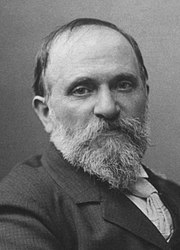Loading AI tools
Irish artist and teacher (1840–1895) From Wikipedia, the free encyclopedia
Thomas Hovenden (December 28, 1840 – August 14, 1895) was an Irish artist and teacher who spent much of his life in the United States. He painted realistic quiet family scenes and narrative subjects and often depicted African Americans.
Thomas Hovenden | |
|---|---|
 Thomas Hovenden in 1895 | |
| Born | December 28, 1840 |
| Died | August 14, 1895 (aged 54) |
| Nationality | Irish |
| Education | Cork School of Design National Academy of Design École des Beaux Arts under Cabanel |
| Known for | Painting |
| Notable work | The Last Moments of John Brown (1884) Breaking Home Ties (1890) |
| Spouse | Helen Corson Hovenden |

Hovenden was born in Dunmanway, County Cork, Ireland.[1] His parents died at the time of the Great Famine and he was placed in an orphanage at the age of six. Apprenticed to a carver and gilder, he studied at the Cork School of Design.
In 1863, he immigrated to the United States. He studied at the National Academy of Design in New York City.[1] He moved to Baltimore in 1868 and then left for Paris in 1874. He studied at the École des Beaux Arts under Cabanel, but spent most of his time with the American art colony at Pont-Aven in Brittany led by Robert Wylie, where he painted many pictures of the peasantry.[1]
Returning to America in 1880, he became a member of the Society of American Artists and an Associate member of the National Academy of Design[1] (elected Academician in 1882). He married Helen Corson in 1881, an artist he had met in Pont-Aven, and settled at her father's homestead in Plymouth Meeting, Pennsylvania, outside of Philadelphia. She came from a family of abolitionists and her home was a stop on the Underground Railroad. Their barn, later used as Hovenden's studio, was known as "Abolition Hall" due to its use for anti-slavery meetings.[2]
He was commissioned by Mr. Robbins Battell[3] to paint a historical picture of the abolitionist leader John Brown. He finished The Last Moments of John Brown (at least two copies exist, in the collection of the deYoung Museum in San Francisco and also the Metropolitan Museum in New York)[1] in 1884.[4] Gift of Mr. and Mrs. Carl Stoeckel in 1897. Accession Number 97.5 Mrs. Stoeckel was Mr. Battell's daughter. His Breaking Home Ties, a picture of American farm life, was engraved with considerable popular success.[1]
In 1886, he was appointed Professor of Painting and Drawing at the Pennsylvania Academy of the Fine Arts, replacing Thomas Eakins who was dismissed due to his use of nude models. Among Hovenden's students were the sculptor Alexander Stirling Calder and the leader of the Ashcan School, Robert Henri.
Hovenden was killed at the age of 54, along with a ten-year-old girl, by a railroad locomotive at a crossing near his home in Plymouth Meeting. Newspaper accounts reported that his death was the result of a heroic effort to push the girl from in front of the train,[1] while a coroner's inquest determined his death was an accident.[2]
A Pennsylvania state historical marker in Plymouth Meeting interprets Abolition Hall and Hovenden.[5] Hovenden House, Barn and Abolition Hall was added to the National Register of Historic Places in 1971.[6] He is buried across the street in the cemetery of the Plymouth Friends Meetinghouse.[7]
Hovenden taught at the Pennsylvania Academy of Fine Arts. One of his students was Henry Ossawa Tanner, an African American who was possibly one of the first Black students to attend the school. Tanner would be famous for painting two images of African Americans, different for portraying them with dignity. These were The Banjo Lesson and The Thankful Poor.
Among Hovenden's works was a series of portraits of two elderly African Americans. His images were different than many made by his contemporaries, because he showed the Black couple as having a sense of dignity, rather than being caricatures.[8] However, he has also been accused of portraying African Americans from a superior point-of-view, the images showing people content in their poverty.[8]
Seamless Wikipedia browsing. On steroids.
Every time you click a link to Wikipedia, Wiktionary or Wikiquote in your browser's search results, it will show the modern Wikiwand interface.
Wikiwand extension is a five stars, simple, with minimum permission required to keep your browsing private, safe and transparent.